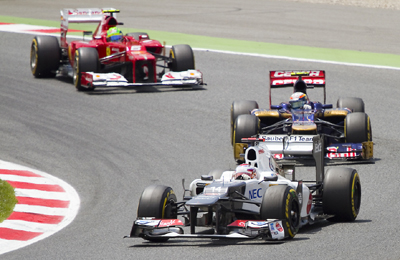
Image: Natursports / Shutterstock.com
New engine, new rules and new sound for F1 in 2014
London, March 7, 2014
By Alan Baldwin
Formula One will look and sound different when the season starts in Melbourne on March 16, with new regulations and the introduction of a turbocharged V6 engine with energy recovery systems.
The following looks at the main changes for 2014, with the sport going through its most significant technical overhaul in at least two decades.
POWER UNIT
Put simply, what used to be called an engine has become something a lot more complicated.
The old 2.4 litre V8 engines, with kinetic energy recovery systems (KERS), that revved at up to 18,000rpm have been consigned to history and replaced by a power unit - a 1.6 litre turbocharged engine limited to 15,000rpm with two energy recovery systems (ERS).
The sport last saw turbo engines in 1988.
Teams are allowed five power units - each made up of six elements - per driver per season, compared to an allocation of eight engines last year.
A driver will have to start from the pitlane if he uses more than five entire units while each additional element above the allocation will incur a 10 place grid penalty.
KERS/ERS
The old-style KERS delivered a boost of around 80bhp for six seconds a lap at the push of a button.
The new ERS - two electrical motor generator units that harvest kinetic and heat energy from the brakes and single exhaust - does not require the driver to push anything and delivers an extra 160bhp for up to 33.33 seconds a lap.
Whereas a KERS failure during a race would have put a driver at a manageable disadvantage, an ERS failure will have a far more dramatic impact.
As a result of ERS, cars will also produce more torque at lower revs than in the past which puts more stress on the rear tyres and calls for more sensitive throttle control.
EXHAUSTS
Cars now have one centrally-positioned exhaust compared to the previous twin outlets.
This change means the end of 'blown diffusers', where hot exhaust gases were directed over the rear diffuser to generate more downforce. Some teams, such as champions Red Bull who used the technology to good effect, have been more hit than others.
FUEL ECONOMY
The new units will use some 35 percent less fuel than the previous engines, as part of a 'green revolution' in the sport. Each car has an allocation of 100kg of fuel to complete the race without refuelling, compared with around 150-160kg last year.
There is a also a fuel flow limiter.
Fuel saving will become a feature of races, with the electrical power generated by ERS coming into play. Driving styles and tactics will have to adapt to the level of fuel consumption.
McLaren expect races to boil down initially into three key segments: "An opening charge to establish position; a consolidatory middle-stint as engines, fuel levels and temperatures are managed; and a final burst as drivers with the machinery and confidence to push, press on to the finish."
GEARBOXES
The rules now specify eight-speed fixed-ratio gearboxes, one more speed than 2013. In the past teams could pick and choose from 30 gear ratios but now they must use the same ones all season, with one change allowed. Any further changes incur penalties.
Each gearbox must now last six consecutive races instead of five previously.
AERODYNAMICS
Front wings have become 150mm narrower, a move aimed at reducing the number of rear punctures caused by cars clipping those in front, and there is no longer a lower beam wing at the rear while the upper part is smaller.
The height of the chassis and nose (415mm lower) has been reduced for safety reasons, chiefly to prevent cars being launched in the air in the event of a front to rear collision and to reduce the risk to drivers from side impacts.
This has led to a variety of highly distinctive noses on the 2014 cars, ranging from the two-pronged Lotus to 'anteater' style fronts on others.
WEIGHT
Minimum car weights have increased from 642kg to 691kg to compensate for the heavier power units. Taller and heavier drivers, such as Force India's Nico Hulkenberg, say the increase is not enough and they are at a disadvantage compared to much smaller rivals such as Williams' Felipe Massa.
With every extra kilo impacting on performance, expect some drivers to look much leaner than in the past.
NOISE
The new power units make a different, softer noise to the screaming V8s, which were introduced in 2006, just as the V8s were distinct to the previous V10s and V12s.
While the engines rev at 15,000rpm, the turbo will make its own distinct noise as it spins at 125,000rpm.
"The car will still accelerate and decelerate rapidly, with instant gearshifts. The engines remain high revving, ultra high output competition engines. Fundamentally the engine noise will still be loud," says Renault's Rob White.
"It will wake you from sleep, and circuit neighbours will still complain.
"The sound of the new generation power units is just different. It's like asking whether you like Motorhead or AC/DC. Ultimately it is a matter of personal taste. Both in concert are still pretty loud."
DOUBLE POINTS
The top 10 finishers in the final race of the season in Abu Dhabi will score double, with the winner taking 50 points instead of the usual 25. This controversial move is aimed at ensuring the title battle stays open as long as possible.
Critics have accused it of being an artificial and unncessary gimmick.
PENALTY POINTS/DRIVER NUMBERS
Any driver collecting 12 penalty points in a calendar year faces an automatic one race suspension.
Drivers have also been allowed to choose their racing numbers, which they will keep for their entire careers in Formula One. Previously their numbers changed from year to year according to the constructors' championship standings. – Reuters







